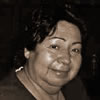
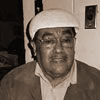
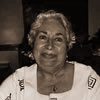

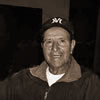
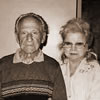
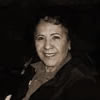

I'm David Greenberger, the creator of Growing Old in East L.A. Since 1979 I've been talking with elderly Americans. As the decades moved along, what started out as conversations at a nursing home in Boston grew into travels around the country: Pennsylvania, Tennessee, Illinois, Oregon. When I embarked on this trip to California, to meet and talk with elderly in East Los Angeles, I set aside everything I'd learned in my previous travels. I approached the East LA residents with a sense of what made them different from me. I thought that language could be a barrier. Having prepared myself by reading about the history and traditions of the Mexicans and the settlement of California. I imagined them as a homogenous group. I arrived having turned them into one interconnected population and I would be the outsider.
Early on my first day of visits to one of the many elderly community centers I was disabused of notions of homogeneous peoples, and of the differences between us. Yes, they all lived in East L.A., but their Mexican-American heritage ran the gamut from a man who said he knew he'd return to Mexico to die, to another who never again wanted to set foot in the country that his father had left after the Mexican revolution more than ninety years ago .
The East Los Angeles region has long had a very high concentration of Latino residents, primarily of Mexican descent. Since the early 20th century, it has been the locus of the Latino population in Los Angeles County. This was not always the case: the areas of northeastern Los Angeles had heavy white populations until the 1930s, when the development of whites-only areas in Mid-Wilshire and the West Side drew away most of the area's white population. In the southern portions of the region, there were also large and diverse non-Latino populations; Boyle Heights was heavily Serbian, Jewish, and Japanese, and Lincoln Heights was heavily Italian. However, most of these groups moved to segregated suburbs after World War II, and Latinos who had been forced into slums seized the opportunity to move into the region's high-quality housing at low prices. East L.A. was overwhelmingly Mexican-American by 1950 and formed the political and cultural heart of Latino life in Los Angeles County.
Hispanic, Latino and Chicano tend to be used interchangeably by those living outside the community but each word has clear implications and associations for those being categorized. One resident I interveiwed , Francisco Mena, said, "I don't like to be called Hispanic, 'cause to me Hispanic is from Central and the Caribbean Islands, so whenever it says, "race," I put "white." I don't put Hispanic. I just put Mexican-American or white, but I don't put Hispanic or Latino." Mexican-American is the usual term of self-description for people with strong ties to the Untied states and Mexico. Anotehr interviewee, Eddie Ramierz commented, "Remember we prefer Mexican-American." For some, it is a generational difference. The elderly residents I spoke with sought assimilation. Later arrivals and their children would seek multiculturalism and then a cultural imperative would gain strength through the Chicano movement. But there is a tremendous amount of diversity within the context of that cultural experience, ranging from new immigrants from Mexico, migration from other states and the longtime presence of multigenerational residents dating back to the ranchos.
Older Mexican-Americans have a different view of their culture than younger generations. Their families moved to the US for the relative prosperity and this intention has deeply impacted their perspectives. They worked diligently and lived through hard times but believed that they had left a harder life behind in Mexican lives. They built American dreams here, with homes, neighborhoods, lifelong friendships, community, churches, families. They created their own opportunities. Their children had educational opportunities that Mexico did not offer. This lure of possibility has a powerful draw. Mexicans continually make the dangerous crossing for what they hope will be a life of greater prosperity in the US.
The stories might seem to stand in conflict to what we know: the hard times of the Depression, racial prejudice from subtle to violent, the gang wars of recent decades, the reality of ongoing poverty. Yet time and again the speakers say, life has been good, things were worse for others, that childhood was happy. They recall that family, community and looking out for one another saw them through. That love of music, faith in God, the kindness of a good teacher gave their life meaning and purpose. Asked about the history of their city, they don't dwell on the news-making event like the Zoot Suit riots, Brown berets or the more recent gang violence, they don't turn to recollections of prejudice, instead they tell of building the American dream: finding good jobs, a house they've been restoring for decades, a coveted pension, a beloved spouse.
I grew up in the suburbs of an industrial city on the Great Lakes, Erie, Pennsylvania. The musicians who composed and played the music in this program, grew up in East LA. As we grow up our neighborhoods change. After decades have gone by, our sense of a hometown becomes something that we carry with us, it's internal. East LA is a place that looks different architecturally, is in a different climate, and has a different ethnic composition to its population than my hometown. But here we are, listening to the same music, liking similar food, stories and art.
I find my way around by meeting a series of individuals. Everybody falls into overlapping categories by which they can be quantified and counted. But over the course of our lives it is the connections we make with other individuals that resonates through the years.
What most of the people I spoke with have in common is a desire and ability to be out in their community. Whatever diminished circumstances or conditions they may be in, by finding a level of involvement that fits their current status, they are fully engaged with life - something new happens to them, no matter how small. It is unfair to gauge the level of activity of the elderly by the same measure used for someone in still in the upswing of their life. It is their attitude about being alive, to welcoming what the day brings that makes them the vibrant people they are.
Los Angeles as a whole, and East Los Angeles in particular, has a network of community centers for the elderly, covering the whole of the area. These serve a vital purpose in a range of ways. they are a regular gathering place, a chance to socialize, celebrate holidays, play games, music, dance. They offer artistic and cultural events and provide medical and information on all of the services that may be of use. For some, they were a way for them to be assured of maintaining a well-balanced diet. some people have known each other prior to attending the centers, other met there and have developed friendships. Throughout our lives we maintain a sense of who we are by a mixture of friends and fmaily who've witnessed the changes that have come to bear, and by meeting new people with whom we move forward from that point onward.